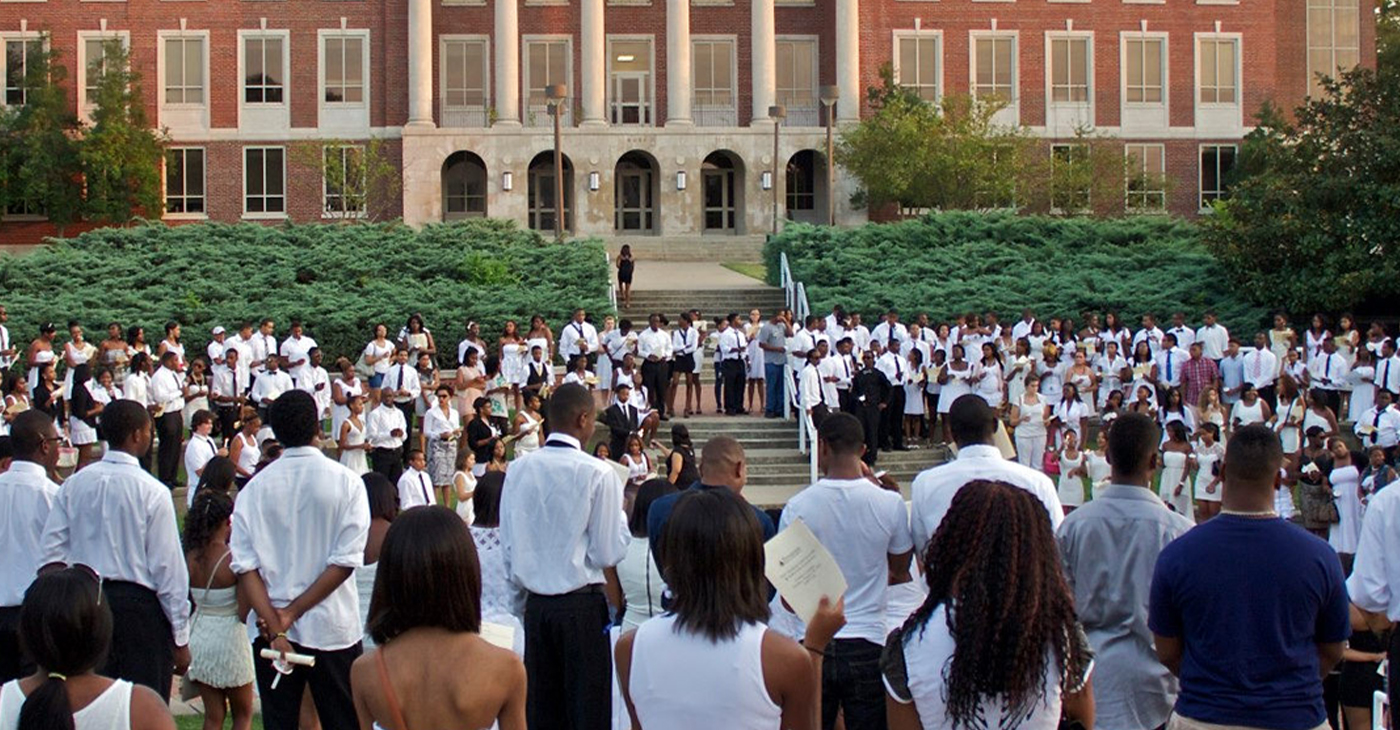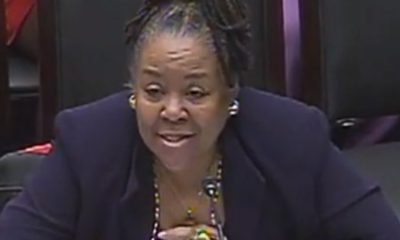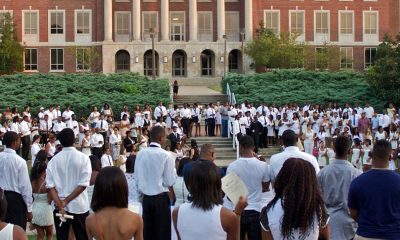#NNPA BlackPress
COMMENTARY: Roger Stone the Fifth Criminal in Trump’s Corruption Ring
NNPA NEWSWIRE — Instead of someone in the Republican Party acknowledging that there is corruption in the White House, they blame the judges and court system for doing their job. Thirty minutes after the jury delivered its verdict on Roger Stone, the president was upset, and tweeted his displeasure that his longtime friend was caught breaking the law on 7 counts.
By Roger Caldwell, NNPA Newswire Contributor
It is time for America to be honest with itself and admit that President Donald Trump is breaking the law. When Trump talks about draining the swamp, he is really talking about his leadership ring.
“Five of Trump’s lieutenants, Michael Flynn, George Papadopoulos, Michael Cohen, Paul Manafort, and now Roger Stone, have all pleaded guilty or have been convicted of a crime. The stench of corruption is all around Donald Trump, and this week’s ruling reminds us just how important and need of Congress’ impeachment inquiry is,” says Terrie Rizzo, Chairwomen of the Florida Democratic Party.
Truth and integrity are rare commodities in President Trump’s inner circle, his administration, and the Republican Party. When someone in Trump’s inner circle is convicted of breaking a law, Republicans refuses to say anything, and act like it did not happen.
Instead of someone in the Republican Party acknowledging that there is corruption in the White House, they blame the judges and court system for doing their job. Thirty minutes after the jury delivered its verdict on Roger Stone, the president was upset, and tweeted his displeasure that his longtime friend was caught breaking the law on 7 counts.
It is crazy to think that the president is mad with Roger Stone being found guilty of five counts of lying to Congress, one of witness tampering, and one of obstructing a congressional committee proceeding.
It appears that the Trump administration is the mafia, and our president is the godfather. The members of the Republican Party seem to have no comment, on Trump’s campaign team breaking the law. All around the world, the different countries are watching America’s corruption starting with the head – who is President Donald Trump and his associates.
America has reached the point of insanity, and everyone is comfortable with lying, and what will the Republicans do. The American people have a right to know the truth, and the impeachment is exposing the corruption and the lawlessness with our president, and his administration.
“Robert Mueller is coming for me,” Stone wrote before asserting that his name was next on what he called Mueller’s “hit list” of targets. Stone denied any wrongdoing and said he faced legal peril simply because he had advised Trump for several decades.
It is amazing that Roger Stone in 2016 thought he had not broken any laws, even though he lied to the Congress. He claimed that Mueller’s investigation was a witch hunt, and he “may frame Stone on some bogus charge.”
During the campaign, Stone had confirmed that he exchanged messages with “Guccifer2.0” which was a front for Russian intelligence operatives. These Russian intelligence operatives stole and leaked emails from senior Democrats, throwing the party and election into turmoil at the height of the 2016 campaign. Stone also claimed to have communicated with Julian Assange, owner of Wiki-Leaks, who published the Democratic emails.
With this new information and conviction, it is obvious that prosecutors are still working on Trump’s Russian corruption with the 2016 election. Rick Gates’ testimony in Stone’s trial proved that Trump had welcomed the release of hacked documents in the 2016 election.
“Gates testified he had witnessed Trump take an evening phone call from Stone as they rode to New York’s LaGuardia Airport from Trump Tower in late July 2016. Stone and Trump apparently discussed Wiki-Leaks’ planned release of hacked Democratic emails,” says Katelyn Polantz – reporter of CNN Politics. They thought these stolen emails was a gift.
In written answers to questions to Mueller, Trump does not remember taking a call from Roger Stone and talking about hacked information from Wiki-Leaks. Stone sentencing is scheduled for February 6, 2020. Back in 2016, Stone stated that he had not broken any laws, and Mueller’s investigation was a witch hunt.
But in November 2019, Roger Stone has been convicted, and the investigation was more than a witch hunt. He may turn state or federal evidence to receive a shorter sentence, based on what he knows. Why is Trump’s corruption ring, still supporting their boss – President Donald Trump?
Disclaimer: The views and opinions expressed in this article do not necessarily reflect the official policy or position of BlackPressUSA.com or the National Newspaper Publishers Association.
#NNPA BlackPress
IN MEMORIAM: Ramona Edelin, Influential Activist and Education Advocate, Dies at 78
NNPA NEWSWIRE — Born on September 4, 1945, in Los Angeles, California, activist Ramona Edelin’s early years were marked by a commitment to education and social justice. According to her HistoryMakers biography, after graduating from Fisk University with a Bachelor’s degree in 1967, she pursued further studies at the University of East Anglia in England. She earned her master’s degree before completing her Ph.D. at Boston University in 1981.
The post IN MEMORIAM: Ramona Edelin, Influential Activist and Education Advocate, Dies at 78 first appeared on BlackPressUSA.

By Stacy M. Brown, NNPA Newswire Senior National Correspondent
@StacyBrownMedia
Once upon a time, Black Americans were simply known as colored people, or Negroes. That is until Ramona Edelin came along. The activist, renowned for her pivotal roles in advancing civil rights, education reform, and community empowerment, died at her D.C. residence last month at the age of 78. Her death, finally confirmed this week by Barnaby Towns, a communications strategist who collaborated with Dr. Edelin, was attributed to cancer.
Born on September 4, 1945, in Los Angeles, California, Edelin’s early years were marked by a commitment to education and social justice. According to her HistoryMakers biography, after graduating from Fisk University with a Bachelor’s degree in 1967, she pursued further studies at the University of East Anglia in England. She earned her master’s degree before completing her Ph.D. at Boston University in 1981.
Edelin’s contributions to academia and activism were manifold. She was pivotal in popularizing the term “African American” alongside Rev. Jesse L. Jackson in the late 1980s.
Jackson had announced the preference for “African American,” speaking for summit organizers that included Dr. Edelin. “Just as we were called Colored, but were not that, and then Negro, but not that, to be called Black is just as baseless,” he said, adding that “African American” “has cultural integrity” and “puts us in our proper historical context.”
Later, Edelin told Ebony magazine, “Calling ourselves African Americans is the first step in the cultural offensive,” while linking the name change to a “cultural renaissance” in which Black Americans reconnected with their history and heritage.
“Who are we if we don’t acknowledge our motherland?” she asked later. “When a child in a ghetto calls himself African American, immediately he’s international. You’ve taken him from the ghetto and put him on the globe.”
The HistoryMakers bio noted that Edelin’s academic pursuits led her to found and chair the Department of African American Studies at Northeastern University, where she established herself as a leading voice.
Transitioning from academia to advocacy, Edelin joined the National Urban Coalition in 1977, eventually ascending to president and CEO. During her tenure, she spearheaded initiatives such as the “Say Yes to a Youngster’s Future” program, which provided crucial support in math, science, and technology to youth and teachers of color in urban areas. Her biography noted that Edelin’s efforts extended nationwide through partnerships with organizations like the National Science Foundation and the United States Department of Education.
President Bill Clinton recognized Edelin’s expertise by appointing her to the Presidential Board on Historically Black Colleges and Universities in 1998. She also co-founded and served as treasurer of the Black Leadership Forum, solidifying her standing as a respected leader in African American communities.
Beyond her professional achievements, Edelin dedicated herself to numerous boards and committees, including chairing the District of Columbia Educational Goals 2000 Panel and contributing to the Federal Advisory Committee for the Black Community Crusade for Children.
Throughout her life, Edelin received widespread recognition for her contributions. Ebony magazine honored her as one of the 100 Most Influential Black Americans, and she received prestigious awards such as the Southern Christian Leadership Award for Progressive Leadership and the IBM Community Executive Program Award.
The post IN MEMORIAM: Ramona Edelin, Influential Activist and Education Advocate, Dies at 78 first appeared on BlackPressUSA.
#NNPA BlackPress
Tennessee State University Board Disbanded by MAGA Loyalists as Assault on DE&I Continues
NNPA NEWSWIRE — Recent legislative actions in Tennessee, such as repealing police reform measures enacted after the killing of Tyre Nichols, underscore a troubling trend of undermining local control and perpetuating racist agendas. The new law preventing local governments from restricting police officers’ authority disregards community efforts to address systemic issues of police violence and racial profiling.
The post Tennessee State University Board Disbanded by MAGA Loyalists as Assault on DE&I Continues first appeared on BlackPressUSA.

By Stacy M. Brown, NNPA Newswire Senior National Correspondent
@StacyBrownMedia
Tennessee State University (TSU), the state’s only public historically Black college and university (HBCU), faces a tumultuous future as Gov. Bill Lee dissolved its board, a move supported by racist conservatives and MAGA Republicans in the Tennessee General Assembly, who follow the lead of the twice-impeached, four-times indicted, alleged sexual predator former President Donald Trump. Educators and others have denounced the move as an attack on diversity, equity, and inclusion (DE&I) and a grave setback for higher education.
Critics argue that TSU’s purported financial mismanagement is a manufactured crisis rooted in decades of underinvestment by the state government. They’ve noted that it continues a trend by conservatives and the racist MAGA movement to eliminate opportunities for Blacks in education, corporate America, and the public sector.
Gevin Reynolds, a former speechwriter for Vice President Kamala Harris, emphasizes in an op-ed that TSU’s financial difficulties are not the result of university leadership because a recent audit found no evidence of fraud or malfeasance.
Reynolds noted that the disbanding of TSU’s board is not an isolated incident but part of a broader assault on DE&I initiatives nationwide. Ten states, including Tennessee, have enacted laws banning DE&I policies on college campuses, while governors appointing MAGA loyalists to university trustee positions further undermine efforts to promote inclusivity and equality.
Moreover, recent legislative actions in Tennessee, such as repealing police reform measures enacted after the killing of Tyre Nichols, underscore a troubling trend of undermining local control and perpetuating racist agendas. The new law preventing local governments from restricting police officers’ authority disregards community efforts to address systemic issues of police violence and racial profiling.
The actions echo historical efforts to suppress Black progress, reminiscent of the violent backlash against gains made during the Reconstruction era. President Joe Biden warned during an appearance in New York last month that Trump desires to bring the nation back to the 18th and 19th centuries – in other words, to see, among other things, African Americans back in the chains of slavery, women subservient to men without any say over their bodies, and all voting rights restricted to white men.
The parallels are stark, with white supremacist ideologies used to justify attacks on Black institutions and disenfranchise marginalized communities, Reynolds argued.
In response to these challenges, advocates stress the urgency of collective action to defend democracy and combat systemic racism. Understanding that attacks on institutions like TSU are symptomatic of broader threats to democratic norms, they call for increased civic engagement and voting at all levels of government.
The actions of people dedicated to upholding the principles of inclusivity, equity, and justice for all will determine the outcome of the ongoing fight for democracy, Reynolds noted. “We are in a war for our democracy, one whose outcome will be determined by every line on every ballot at every precinct,” he stated.
The post Tennessee State University Board Disbanded by MAGA Loyalists as Assault on DE&I Continues first appeared on BlackPressUSA.
#NNPA BlackPress
Braxton Haulcy and the Expansion of Walker|West Music Academy
May 24, 2023 – Walker West Music Academy gets an early start on expansion. Join us for a Wednesday episode of The …
The post Braxton Haulcy and the Expansion of Walker|West Music Academy first appeared on BlackPressUSA.

May 24, 2023 – Walker West Music Academy gets an early start on expansion. Join us for a Wednesday episode of The …
The post Braxton Haulcy and the Expansion of Walker|West Music Academy first appeared on BlackPressUSA.
-

 Activism4 weeks ago
Activism4 weeks agoOakland Post: Week of March 27 – April 2, 2024
-

 #NNPA BlackPress4 weeks ago
#NNPA BlackPress4 weeks agoBeloved Actor and Activist Louis Cameron Gossett Jr. Dies at 87
-

 Community1 week ago
Community1 week agoFinancial Assistance Bill for Descendants of Enslaved Persons to Help Them Purchase, Own, or Maintain a Home
-

 Activism3 weeks ago
Activism3 weeks agoOakland Post: Week of April 3 – 6, 2024
-

 Business1 week ago
Business1 week agoV.P. Kamala Harris: Americans With Criminal Records Will Soon Be Eligible for SBA Loans
-

 Activism2 weeks ago
Activism2 weeks agoOakland Post: Week of April 10 – 16, 2024
-

 Community1 week ago
Community1 week agoAG Bonta Says Oakland School Leaders Should Comply with State Laws to Avoid ‘Disparate Harm’ When Closing or Merging Schools
-

 Community6 days ago
Community6 days agoOakland WNBA Player to be Inducted Into Hall of Fame


























































